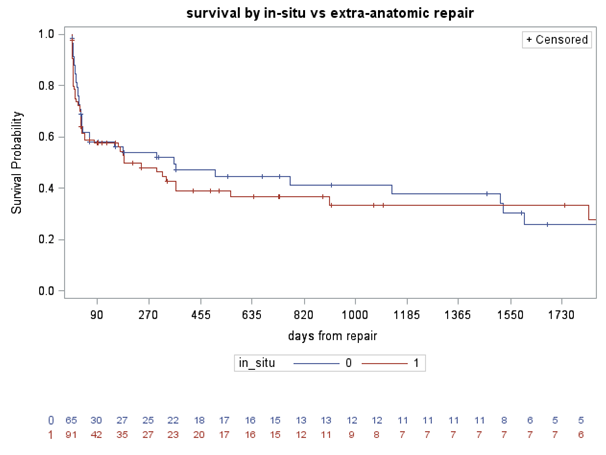In-situ Bypass and Extra-anatomic Bypass Procedures Result in Similar Survival in Patients with Secondary Aorto-Enteric Fistula
Matthew R. Janko, MD1, Robert Hacker, MD2, Peter Lawrence, MD3, Karen Woo, MD3, Jayer Chung, MD, MPH4.
1University Hospitals, Cleveland, OH, USA, 2Mercy Hospital, Toledo, OH, USA, 3University of California, Los Angeles, CA, USA, 4Baylor University, Houston, TX, USA.
OBJECTIVES: The optimal revascularization modality in secondary abdominal aortoenteric fistula (SAEF) is debated, although in-situ bypass (ISB) has increasingly been used. Therefore, we aimed to quantify the association between extra-anatomic (EAB) versus ISB mortality in SAEF.
METHODS: A retrospective, multi-institutional study of SAEF from 2002-2014 was performed. Baseline demographics, comorbidities, procedural, operative, and postoperative variables were recorded, with the primary outcome being mortality at last follow up.
RESULTS: 223 patients at 31 institutions presented with SAEF (median age 72 years; 77% male), which was treated with 171 bypass grafts and 48 endografts. 101 (45%) were managed with ISB: 48 antibiotic-soaked, 17 autogenous femoral vein (NAIS), 31 cryopreserved allografts, and 5 untreated prosthetic grafts; 70 (31%) underwent EAB with infected graft excision. The remainder underwent endografts (10; 5%), partial replacements (33; 15%), or medical-only management (4; 2%). Comparing EAB versus ISB, EAB patients were older (age 73 vs. 69; p<0.01), more frequently infected with Streptococcus (63% vs 37%, p=0.02), more frequently treated with fluoroquinolones (83% vs 17%, p < 0.01), and endured less operative hemorrhage (1200mL vs. 4000mL; p < 0.01). There were otherwise no significant differences in presentation, comorbidities, intra-operative or postoperative variables. Overall median Kaplan-Meier (KM) estimated survival was 270 days. When stratified by EAB versus ISB, there was no significant difference in KM estimated survival (p=0.85; Fig). Multivariable Cox regression showed the duration of antibiotic use (HR 0.98 95% CI 0.96, 0.99; p < 0.01) and omental wrapping (HR 0.52 95% CI 0.33, 0.81; p < 0.01) independently decreased mortality.
CONCLUSIONS: In this largest reported cohort of SAEF, fewer than 50% of patients survived for nine months after presentation. ISB does not offer a survival advantage compared to EAB. Each week of antibiotic use decreases mortality by 2%, while omental wrapping decreases mortality by 48%. Prospective multicenter registry data can provide additional data improve survival in patients with SAEF. 
Back to 2019 Abstracts
